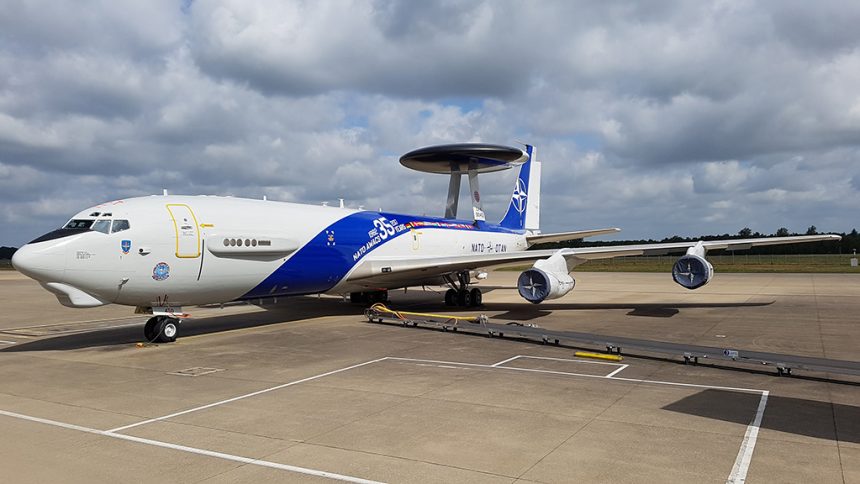Special Color Scheme Showcases Multinational AWACS Operations for NATO.
Special paint scheme aircraft are always interesting news but even more so when they are large ones. A newly painted NATO E-3A Sentry Airborne Warning and Control (AWACS) aircraft was unveiled in Geilenkirchen, Germany, yesterday Jun. 12, to celebrate 35 years of Boeing E-3A Sentry operation for NATO. Noteworthy, another E-3 was painted in special color scheme recently, in anticipation of NATO Tiger Meet 2017.
The newly painted aircraft features a clean-looking coat of the standard grey color with the large distinctive NATO blue stripe wrapping under the fuselage and continuing up onto the tail of the aircraft. Flags of NATO member nations are included on the large fuselage stripe while the tail wears a large NATO compass rose logo against the blue background.
“The special painted AWACS gives great exposure to the task and mission of the NATO Airborne Early Warning and Control Force,” said Lieutenant Colonel Raimon Schulz, Chairman of the 35th Anniversary Committee. “The anniversary aircraft will be flown for the upcoming 6 years and the decals can be adjusted to other special events like the celebration of 70 years NATO in 2019. The flags on the sides of the aircraft symbolize the multinational character of this unique unit within NATO,” Schulz told media in a press release on the NATO AWACS website.
For those who may be unfamiliar with AWACS operations, these Airborne Warning And Control aircraft use a large, distinctive hydraulically rotated saucer-shaped antenna on top of an updated Boeing 707 airframe. The large, rotating housing holds various versions of the Westinghouse Corporation’s AN/APY-1 and AN/APY-2 passive electronically scanned array radar system. The radars housed inside the saucer provide detailed radar imagery of the airspace from the ground up to high altitude. Radar monitoring and air control operators on board the E-3A AWACS aircraft communicate with aircraft in a crowded conflict zone to provide communication and datalinks, provide vectoring of air assets and traffic control into and out of target and patrol areas and assist with intercepts of aerial targets.
The NATO E-3A component has been deployed to nearly every air combat operation in the last three decades in the region and has been especially active in the Mediterranean and Middle East where the tempo of tactical air operations often requires a highly capable airborne traffic control, communications hub and surveillance asset.









